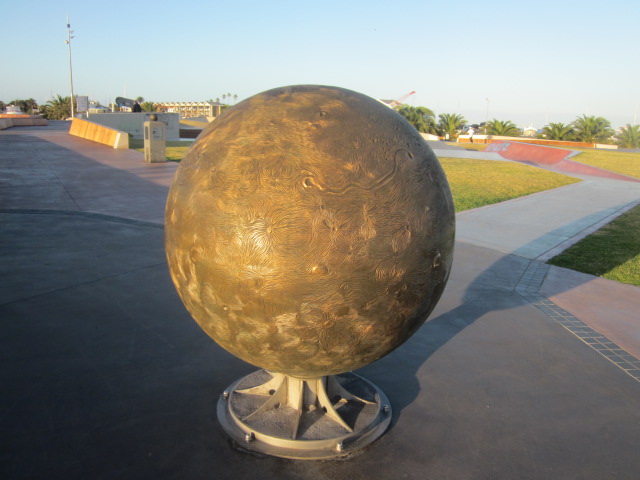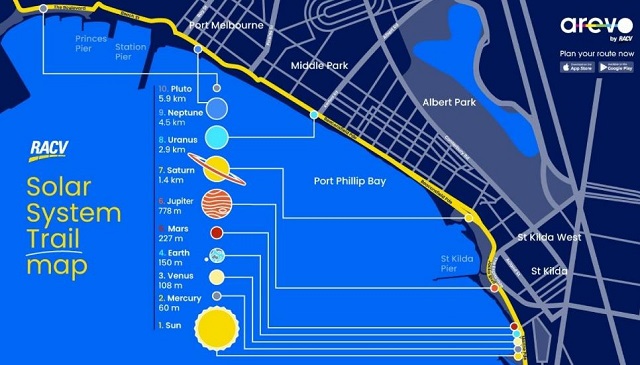Solar System Trail (St Kilda - Port Melbourne)


Port Phillip's 5.9km Solar System trail adds a celestial element to the foreshore between St Kilda and Port Melbourne. It has sun and planet sculptures which replicate the solar system on a cosmic scale of one to one billion. Navigate the solar system from the sun at the St Kilda Marina Reserve to the outer planets.
In 2008 artists and scientists constructed a model of our solar system to a scale of one to one billion between St Kilda and Port Melbourne. Instead of navigating 4.5 billion kilometres from the sun to Neptune, and 5.9 billion kilometres from the sun to Pluto, you only travel 4.5 kilometres and 5.9 kilometres. The foreshore has always been a superb location to view the sun setting on the western horizon. Port Phillip Bay's crescent shape is perfect for a model where the 'sun' can be viewed from
every one of the nine model locations.

Remember:
Every millimetre you walk is 1000 kilometres.
Every centimetre you walk is 10,000 kilometres.
Every metre you walk (one and a half steps) is 1,000,000 kilometres.
When you walk 5.9 kilometres from the Sun (Marina Reserve) to Pluto (Port Melbourne), you have travelled 5.9 billion kilometres.
Planets - Actual diameters - Model size - Actual distance from the Sun - Walking distance from Sun
1. Sun - 1,392,000 km - 139 cm
2. Mercury 4,878 km - 0.5 cm - 60 million km - 60 m
3. Venus 12,102 km - 1.2 cm - 108 million km - 108 m
4. Earth 12,756 km - 1.28 cm - 150 million km - 150 m
Earth's moon 38 cm from earth
5. Mars 6,792 km - 0.67 cm - 227 million km - 227 m
6. Jupiter 142,980 km - 1.43 cm - 778 million km - 778 m
7. Saturn 120,536 km - 12 cm - 1.4 billion km - 1.4 km
8. Uranus 51,118 km - 5.1 cm - 2.9 billion km - 2.9 km
9. Neptune 49,528 km - 4.9 cm - 4.5 billion km - 4.5 km
10. Pluto 2,340 km - 0.24 cm - 5.9 billion km - 5.9 km
Start at the Sun
The trail starts at the sun sculpture, near the white lighthouse in Marina Reserve at the south end of St Kilda Beach. From the sun follow the foreshore trail north to visit the eight planets, accurately scaled to size and distance. You can walk to the first five planets within twenty minutes. The furthest object, the dwarf planet Pluto at Sandridge Beach, can be reached within ninety minutes.
Our Environment
Seeing the Earth on a human scale shows its immense isolation and vulnerability. In the vastness of space it is imperative for us to care for this precious environment of our only home.
Sand in Space
The beach is a clue to the immensity of the universe. Pick up a handful of sand as you walk. It contains about 10,000 grains. Imagine that each grain is one star like our sun. Reflect that there are about ten times as many stars as grains of sand on all the world's beaches and deserts combined. There are an estimated 70,000 million million million stars (seven followed by twenty-two zeros) in the observable universe.
Our sun is just one star of more than 300 billion stars in the Milky Way galaxy. Our galaxy is just one of more than 100 billion galaxies in the observable universe which is probably a minuscule fraction of the actual number.
Solar System Trail
Our solar system consists of the sun, eight planets, hundreds of moons and countless asteroids, comets, dwarf planets and other small bodies.
It formed about 5 billion years ago from a cloud of gas and dust left behind by dying stars. This cloud gravitationally collapsed into a rotating disk. Most of the material gathered at the centre to form the sun. Smaller amounts further out formed the planets. As planets orbited they swept the area around them clear of rock.
Of the eight planets, the inner four are rocky while the outer planets - Jupiter, Saturn, Uranus and Neptune - are gas giants. Spacecraft missions since the mid-1970s have hugely increased our knowledge of the planets. Spacecraft cannot land on the gas giants, only on some of their moons, for instance, the Huygens Probe that landed on Titan, Saturn's largest moon in 2005.
1. The Sun is a star, one of 300 billion in the Milky Way galaxy and is about five billion years old. All life on Earth depends on the light and heat from the Sun. It is 110 times the Earth's diameter. It is has an estimated surface temperature of 5,800C and a core temperature of 20,000,000C. It is a middle-aged star, at least 4.6 billion years old but has an expected lifespan of 10-12 billion years. The Sun contains 99.86% of the total mass of the solar system and its gravity holds all of the planets in orbit.
Proxima Centauri, closest star to us after the Sun
After the Sun, the closest star to us is a small Red Dwarf star, Proxima Centauri. It is too faint to be seen without using a sizeable telescope. It is 4.24 light years away, so in our model, which is 1:1 billion scale, it is 40,140 kilometres away. This is approximately the distance around the circumference of the world from Melbourne to Melbourne. A model of Proxima Centauri, which is the size of a basketball, is near the Sun. The closest star we can see with our naked eyes is Alpha Centauri, the brighter of the two pointers to the Southern Cross. It is a binary, or double star, with each being about the size of the Sun. It is about 4.3 light years away which would be 40,709 kilometres from the Sun in the model, which is around the world and about 700 kilometres further.
2. Mercury is the closest planet to the Sun. Like the Earth's moon it is a grey barren world covered in a thick layer of dust and heavily scarred with impact craters. These craters never erode because of the lack of atmosphere. Mercury at times can be seen close to the Sun, just after sunset or just before sunrise. The ancient Greeks believed it to be two separate objects: Apollo in the morning and Hermes in the evening.
3. Venus is similar in size to Earth. It is a hellish world with crushing pressures, scorching temperatures and sulphuric acid rain. The Russian Venera 13 spacecraft survived only 2 hours and 7 minutes after arrival. Venus shines brilliantly because of a thick atmosphere of carbon dioxide. The 'evening' or 'morning' star, as it is often called, appears soon after sunset or not long before sunrise. Twice in every 120 years Venus passes or 'transits' between the Earth and the Sun, including in1874, 1882, 2004 and 2012.
The Transit of Venus played a major role in Australian history. Captain James Cook, whose statue stands east of St Kilda Pier, claimed Terra Australis for the British crown in 1770 when, after observing the 1769 Transit at Tahiti, he was directed to search for the 'great southern land'.
4. Earth is unique, the only place we know of in the Solar System and galaxy that supports life. It lies within the Sun's 'habitable zone' with liquid water on its surface and with life-supporting concentrations and amounts of chemicals. The core of iron is covered by a thick mantle of liquid rock. Continents and oceans float on the thin outer crust of solid rock. The atmosphere is 78% nitrogen, 21% oxygen, a little carbon dioxide and other gases. The moon is about one quarter the diameter of the Earth. Scientists believe it was formed after an object the size of Mars collided with the Earth when it was very young.
5. Mars has inspired curiosity and imagination for thousands of years, including theories of advanced civilisations however there is no evidence of life on the planet. Its famous red colour is due to iron oxide on the surface. The tilted axis creates seasons and there are often violent dust storms. Its spectacular features include the immense volcano 'Olympus Mons' (27km high) and the vast canyon 'Valles Marineris' with a length about the distance from Sydney to Perth (4000km). The two moons, Phobos and Deimos, are actually small captured asteroids.
6. Jupiter contains more than twice as much material as all the other planets combined. The atmosphere is thousands of kilometres deep with hydrogen, helium, methane and ammonia. It has at least seventy moons and a faint ring system. Io, one of Jupiter's largest moons, is the most volcanic planet or moon in the Solar System. Europa has an ice crust above an ocean of water. Ganymede, the largest moon in the Solar System, is made of rock and ice. 'The Great Red Spot' is a cyclonic storm up to three times the Earth's diameter, which has been observed for at least 300 years.
7. Saturn, one of the four gas giants, is famous for its spectacular system of rings made from billions of icy rocks, sized from small grains to kilometres wide. It has about sixty moons. Titan, the largest, is the only moon in the Solar System with an atmosphere (nitrogen). It also has lakes of liquid methane discovered by the Huygens Probe which landed in 2005.
8. Uranus lies on its side causing it to 'roll' around the Sun. Strangely, its equator has been tilted more than ninety degrees to its orbit. Perhaps early in its history it collided with a huge unknown object. In 1781 it was the first planet since ancient times to be discovered (by William Herschel). The atmosphere is mainly hydrogen with some helium and methane. Of its thirty or so moons, Titania, Oberon, Umbriel and Arial are over 1000 km in diameter. It has a faint ring system discovered in 1977 when it moved in front of a star.
9. Neptune is a cold distant gas giant. Through a telescope it is bluer than Uranus because it has more methane. Giant storms whirl through its atmosphere with the fastest winds recorded in the Solar System, up to 2,400 km/h. One storm, nearly as large as Earth, circles the planet every eighteen hours. In 1989 the Voyager 2 spacecraft discovered eleven small moons and a faint ring system. Triton is the largest (2,700km in diameter) as well as being the coldest moon in the Solar System. Geysers of nitrogen spew from its surface.
10. Pluto, discovered in 1930, is a tiny world smaller than the Earth's moon. Charon, one of its five moons, is half the size of Pluto. Beyond Neptune are tens of thousands of asteroids of ice and rock left over from when the planets were formed. This asteroid belt is called the 'Kuiper Belt'. In 2005 a Kuiper Belt Object (KBO) larger than Pluto was located and named Eris. Now we realise that Pluto is just one of these large asteroids or 'Dwarf Planets'. The New Horizons spacecraft reached Pluto in July 2015, after a nine year voyage, to study Pluto, Charon and other KBO's. Part of Pluto's orbit can be closer to the Sun than Neptune.
Map Credit: RACV
Location
34 Marine Parade, St Kilda 3182 Map
Web Links
→ Solar System Trail Brochure (PDF)











